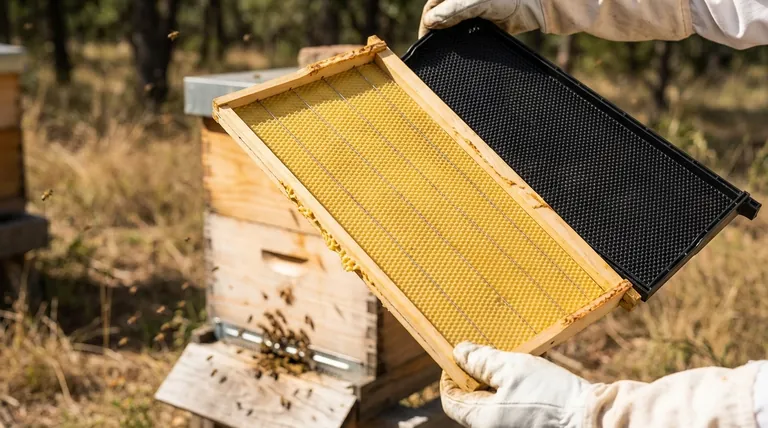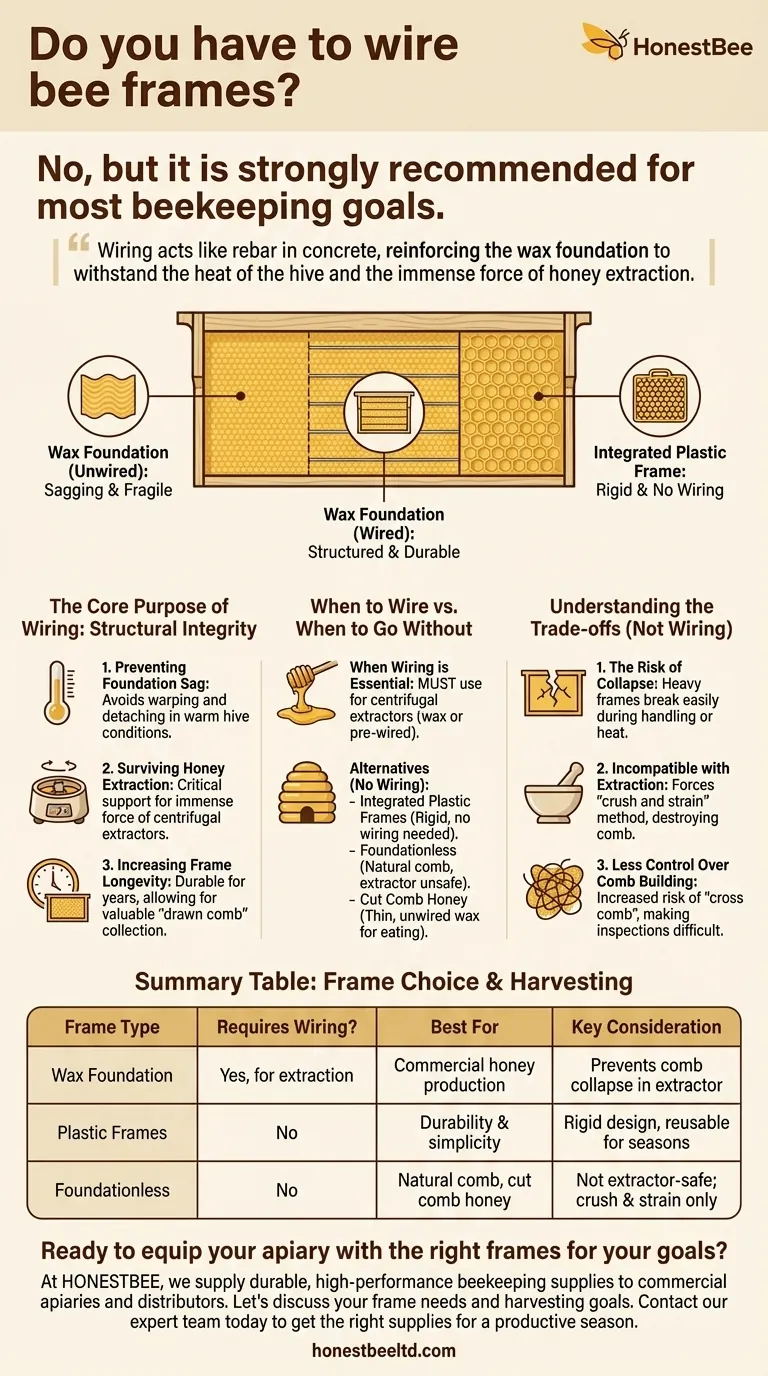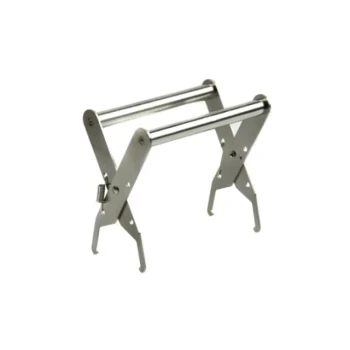In short, no, you do not have to wire every bee frame, but it is strongly recommended for most beekeeping goals. Wiring is a critical step for any frames you intend to use for honey harvesting with a centrifugal extractor. It provides the structural support necessary to prevent the wax comb from disintegrating under force.
The choice to wire a frame is not about the bees' needs, but about the beekeeper's process. Wiring acts like rebar in concrete, reinforcing the wax foundation to withstand the heat of the hive and the immense force of honey extraction, ensuring the comb can be emptied and reused.

The Core Purpose of Wiring: Structural Integrity
Wiring a frame serves one primary purpose: to support the wax or foundation sheet embedded within it. This support is crucial in several scenarios.
Preventing Foundation Sag
The inside of a beehive is a warm, humid environment. A sheet of pure beeswax foundation, especially a large one in a deep frame, can easily soften in the heat. Without the support of wires, this foundation can sag, warp, or detach from the frame entirely, leading to poorly built and unworkable comb.
Surviving Honey Extraction
This is the most critical reason for wiring. Honey extractors use centrifugal force to spin honey out of the comb. A frame full of honey is incredibly heavy, and the force exerted during extraction is immense. An unwired comb will tear apart, destroying the bees' hard work and making a mess of your equipment. A properly wired frame holds the comb securely, allowing it to be emptied and returned to the hive for the bees to refill.
Increasing Frame Longevity
Wired frames are far more durable than their unwired counterparts. The wire holds the drawn-out comb securely in place for years of use. This allows you to build a collection of "drawn comb," which is a valuable resource that gives your bees a significant head start during the nectar flow.
When to Wire vs. When to Go Without
Your beekeeping goals directly dictate whether you need to wire your frames. The choice generally comes down to your foundation type and your intended harvesting method.
When Wiring is Essential
You must use wire or a frame with equivalent support if you plan to use a centrifugal extractor. This applies to frames with wax foundation that you embed wires into yourself or pre-wired foundation sheets.
Alternatives That Don't Require Wiring
Modern beekeeping offers several alternatives to traditional wiring.
- Integrated Plastic Frames: Many beekeepers now use frames made entirely of plastic, which have the cell pattern of a foundation molded directly into them. These are rigid by design and require no wiring. They are often coated in a thin layer of beeswax to encourage the bees to build on them.
- Foundationless Beekeeping: Some beekeepers prefer to let the bees build their own comb naturally, without any foundation at all. In this case, an empty frame is used, often with a small wooden or wax "starter strip" along the top bar to guide the bees. These frames cannot be used in an extractor.
- Producing Cut Comb Honey: If your goal is to produce cut comb—squares of honeycomb to be eaten wax and all—you do not want wires running through it. For this, you would use a thin, unwired sheet of surplus wax foundation in your honey supers.
Understanding the Trade-offs
Choosing not to wire your frames has significant consequences for how you manage your hives and harvest honey.
The Risk of Collapse
An unwired frame with wax foundation is fragile. A heavy frame full of honey can break apart simply from being handled clumsily during an inspection, especially on a hot day. This creates a major cleanup job and sets the colony back.
Incompatible with Centrifugal Extraction
This is the most important trade-off. If you do not wire your frames, you forfeit the ability to use a centrifugal extractor. Your only option for harvesting is the "crush and strain" method, where you scrape all the comb off the frame and crush it to release the honey. This destroys the comb, forcing the bees to rebuild it from scratch every single time.
Less Control Over Comb Building
While foundationless frames allow for natural comb, they also increase the risk of "cross comb," where bees build comb that connects across multiple frames. This makes hive inspections incredibly difficult, as you cannot pull frames out without tearing the comb apart.
Making the Right Choice for Your Goal
Ultimately, the type of frame you choose sets the stage for your entire beekeeping journey.
- If your primary focus is efficient honey production with an extractor: You must use wired frames or rigid plastic frames to ensure your comb survives the harvest.
- If your primary focus is natural beekeeping or producing cut comb: You can use foundationless frames or unwired foundation, but you must accept that you cannot use an extractor and will use the crush-and-strain method.
- If your primary focus is simplicity and durability: Integrated plastic frames offer a popular, durable, and reusable option that completely bypasses the need for wiring.
Your frame choice is a foundational decision that will dictate your harvesting methods and management style for years to come.
Summary Table:
| Frame Type | Requires Wiring? | Best For | Key Consideration |
|---|---|---|---|
| Wax Foundation | Yes, for extraction | Commercial honey production | Prevents comb collapse in extractor |
| Plastic Frames | No | Durability & simplicity | Rigid design, reusable for seasons |
| Foundationless | No | Natural comb, cut comb honey | Not extractor-safe; crush & strain only |
Ready to equip your apiary with the right frames for your goals?
At HONESTBEE, we supply durable, high-performance beekeeping supplies to commercial apiaries and distributors. Whether you need reliable wired frames for maximum honey yield or efficient plastic frames for simplified management, our wholesale-focused operations ensure you get the equipment your business depends on.
Let's discuss your frame needs and harvesting goals. Contact our expert team today to get the right supplies for a productive season.
Visual Guide

Related Products
- Plastic Bee Frame Beekeeping Hive Frames for Wholesale
- Assembled Wooden Bee Frames with Beeswax Foundation Ready to Use by HONESTBEE
- HONESTBEE Wired and Assembled Wooden Bee Frames Foundation for a Thriving Hive
- Assembled Wooden Bee Frames with Plastic Foundation for Durability and Convenience by HONESTBEE
- Durable Galvanized Steel Frame Grip
People Also Ask
- Are plastic frames good? Boost Apiary Efficiency with Durable, Pest-Resistant Frames
- Why are plastic frames popular in commercial beekeeping? Boost Efficiency & Durability at Scale
- What are the advantages of plastic frames for beehives? Boost Apiary Efficiency & Durability
- What are the differences between wooden and plastic frames in beehives? Choose the Best for Your Apiary
- What are the main types of frames available for beehives? Wood vs. Plastic for Your Apiary



















